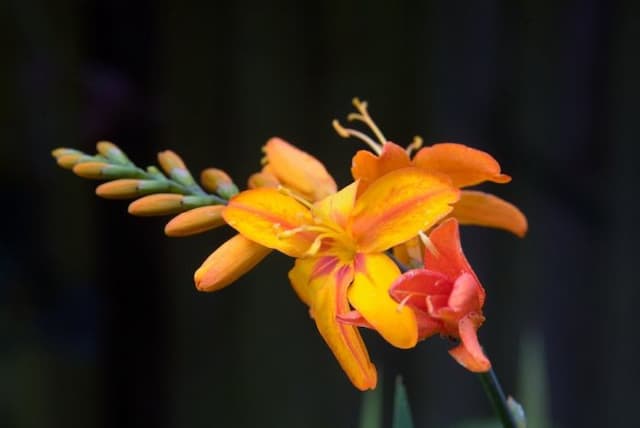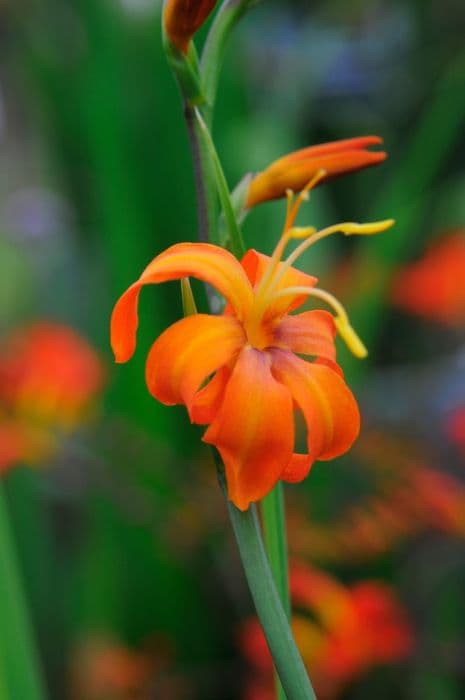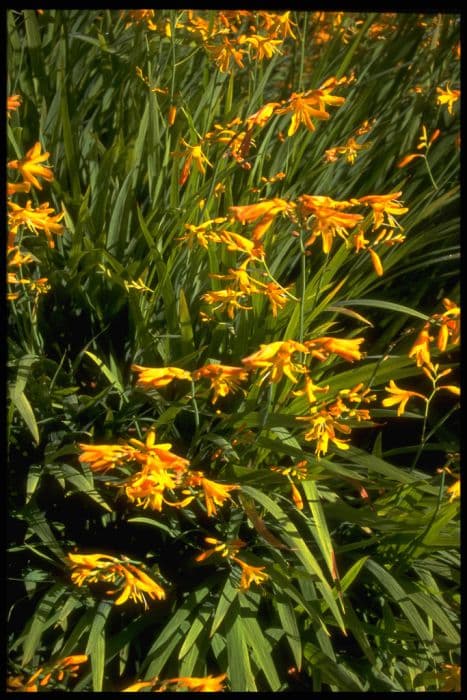Tall Bearded Iris Iris 'Breakers' (TB)

ABOUT
Iris 'Breakers' (TB) is known for its captivating beauty. This variety of iris displays showy blossoms which are a stunning shade of sky blue. The flowers boast striking ruffles along the edges, adding to their dramatic presentation. The petals are elegantly arrayed with the three large lower ones, called falls, gracefully arching downward. These are often adorned with a touch of white or yellow at their bases, near the flower's center, offering a lovely contrast to the blue. In the middle of the falls, you may notice delicate veining or a wash of darker blue, enhancing the depth of their appearance. Above the falls are the standards, which are the three upright petals contributing to the plant's regal stance. These standards are typically of the same vivid blue color, creating a cohesive look throughout the flower. In the heart of the bloom, beards are visible—these fuzzy, caterpillar-like structures usually present a lighter tone which could be white, yellow, or blue, offering a textural contrast against the smooth petals. Aside from the attractive flowers, Iris 'Breakers' has sword-shaped, upright leaves that are a deep, rich green. These leaves fan out from the base of the plant, creating a lush, verdant backdrop for the stunning blossoms. This iris variety tends to bloom in the late spring, providing a vibrant and breathtaking display in gardens and landscapes where they are planted.
About this plant
 Names
NamesFamily
Iridaceae
Synonyms
Tall Bearded Iris, Bearded Iris
Common names
Iris 'Breakers' (TB).
 Toxicity
ToxicityTo humans
The Tall Bearded Iris, including the 'Breakers' cultivar, is considered to have a low level of toxicity to humans. However, ingestions of any part of the plant, particularly the rhizomes (underground stems), can cause digestive disturbances. If someone consumes part of a Tall Bearded Iris, they may experience symptoms such as nausea, vomiting, abdominal pain, and diarrhea. While not life-threatening, these symptoms can be uncomfortable, and anyone suspected of having ingested iris material should seek medical advice.
To pets
The Tall Bearded Iris, or 'Breakers', may be toxic to pets if ingested. Consumption of the rhizomes is most commonly associated with toxicity, and can lead to symptoms such as gastrointestinal upset including vomiting, drooling, diarrhea, and abdominal pain. Although the toxicity is generally considered mild, ingestion can still cause noticeable discomfort for the animal. If you suspect your pet has ingested any part of a Tall Bearded Iris, it is advised to contact a veterinarian.
 Characteristics
CharacteristicsLife cycle
Perennials
Foliage type
Deciduous
Color of leaves
Green
Flower color
Blue
Height
3 feet [91 cm]
Spread
1-2 feet [30-60 cm]
Plant type
Bulb
Hardiness zones
3-9
Native area
Europe
Benefits
 General Benefits
General Benefits- Enhances Garden Aesthetics: The Iris 'Breakers' adds striking color and unique flower shape to gardens, enhancing visual interest.
- Perennial Growth: As a perennial, it returns each year, providing long-term garden enjoyment without the need to replant annually.
- Spring Bloomer: Blooms in the spring, offering early-season color when many other plants are just starting to emerge.
- Attracts Pollinators: The flowers attract bees and butterflies, supporting local ecosystems and pollination.
- Drought Tolerance: Once established, Iris 'Breakers' can be quite drought resistant, requiring less frequent watering.
- Easy to Divide: The rhizomes can be easily divided to propagate new plants and expand garden coverage or share with others.
- Low Maintenance: Requires minimal care beyond basic watering and occasional fertilizing, making it suitable for gardeners of all levels.
- Cold Hardy: Tolerates colder climates well, making it a suitable addition to many gardens across different USDA zones.
 Medical Properties
Medical PropertiesThis plant is not used for medical purposes.
 Air-purifying Qualities
Air-purifying QualitiesThis plant is not specifically known for air purifying qualities.
 Other Uses
Other Uses- Crafts: The dried petals of the Iris 'Breakers' can be used in potpourri mixes or pressed flower crafts, providing a lasting beauty and subtle floral scent.
- Fabric Dye: The blooms can be used to create a natural dye for fabrics, offering tones of blue and purple depending on the mordant used.
- Photography: This variety provides a striking subject for floral photography due to its vibrant color and intricate petal patterns.
- Gastronomy: While not a common ingredient, its petals could theoretically be crystallized with egg whites and sugar and used as an exotic garnish for desserts, provided they haven’t been treated with pesticides or chemicals.
- Wedding Decor: The Iris 'Breakers' can be used in wedding bouquets and table arrangements for their symbolic meanings of hope, faith, and wisdom.
- Garden Companions: Planting Iris 'Breakers' among vegetables can add color and variety to a kitchen garden while possibly deterring certain pests with their strong fragrance.
- Educational Tool: This plant can be used in educational settings to teach about plant genetics and hybridization due to its cultivated nature.
- Water Features: Because of their affinity for moist soil, they can be planted around ponds or water features to enhance the aesthetic of water gardens.
- Natural Fencing: Tall bearded irises can provide a degree of privacy and can be used to create visually appealing borders or natural fencing in gardens.
- Ink Making: The pigment of the Iris 'Breakers' petals could be used in the preparation of natural inks for art or traditional writing techniques.
Interesting Facts
 Feng Shui
Feng ShuiThe Iris is not used in Feng Shui practice.
 Zodiac Sign Compitability
Zodiac Sign CompitabilityThe Iris is not used in astrology practice.
 Plant Symbolism
Plant Symbolism- Faith - The iris often represents faith, demonstrating belief in the unknown and unseen.
- Hope - Signifying hope, the iris can be a symbol to remain positive about the future.
- Courage - The bold appearance of the iris stands for courage and admiration.
- Wisdom - Traditionally, the iris is symbolic of wisdom and cherished for its intelligence.
- Royalty - With its regal posture and often purple color, the iris is frequently associated with royalty and nobility.
- Spirituality - Due to its mystical appearance, the iris symbolizes spiritual endeavors and connections.
 Water
WaterTall Bearded Irises like 'Breakers' need thorough watering to establish roots and during the growing season, but they dislike standing water. Water deeply once a week, providing about a gallon per plant, especially during dry spells. Increase frequency to twice a week during hot, dry weather. Once established, irises are drought-tolerant and excessive water can promote root rot. During winter dormancy, reduce watering significantly.
 Light
LightTall Bearded Irises require full sun to bloom well, so 'Breakers' should be planted in a location where it receives at least six hours of direct sunlight each day. Partial shade is tolerated, but may reduce blooming. Avoid overly shaded areas which can lead to poor growth and fewer flowers.
 Temperature
TemperatureTall Bearded Irises thrive in a temperature range that typically falls between 35 and 90 degrees Fahrenheit. 'Breakers' can tolerate temperatures down to 10 degrees Fahrenheit in winter and up to 100 degrees Fahrenheit in summer, but for optimal growth and flowering, aim to provide a climate that hovers around 70 to 80 degrees Fahrenheit during the growing season.
 Pruning
PruningPrune 'Breakers' after blooming by cutting flower stems close to the base to encourage healthy new growth. Remove any brown or damaged leaves throughout the growing season. In late fall, cut back foliage to a height of about 4 to 6 inches to tidy the plant and reduce overwintering pests and diseases. The best time for major pruning is immediately after bloom, usually in late spring or early summer.
 Cleaning
CleaningAs needed
 Soil
SoilTall Bearded Iris 'Breakers' prefers well-draining soil with a pH of 6.8 to 7.0. A soil mix of loamy, rich garden soil amended with compost and coarse sand is ideal to promote good drainage and provide nutrients.
 Repotting
RepottingTall Bearded Iris 'Breakers' should be divided and repotted every 3 to 4 years to maintain vitality and prevent overcrowding. Best repotted after flowering, typically in late summer.
 Humidity & Misting
Humidity & MistingTall Bearded Iris 'Breakers' is tolerant of the humidity levels typically found in temperate climates and does not require specific humidity adjustments for optimal growth.
 Suitable locations
Suitable locationsIndoor
Grow Tall Bearded Iris in sunny spot with good airflow.
Outdoor
Plant in sunny area with good drainage.
Hardiness zone
3-9 USDA
 Life cycle
Life cycleIris 'Breakers', commonly known as Tall Bearded Iris, begins its life cycle when a seed germinates, typically in late summer, sprouting into a small plant with a rhizome (an underground stem) and roots. The rhizome establishes itself and produces sword-like leaves during the first growing season, gathering energy for future blooms. By the second year, the iris matures and is ready to produce its characteristic large, ruffled flowers in various shades of blue and purple, which typically bloom in late spring to early summer. After flowering, the plant enters a period of dormancy during the hotter months, where leaf growth slows and the plant conserves energy. The rhizome may be divided during late summer to propagate new plants and invigorate older clumps. Annually, the cycle continues with new growth in the spring, flowering, and then dormancy, with the plant gradually expanding in size through additional rhizome development.
 Propogation
PropogationPropogation time
Late Summer
Propogation: The most popular method of propagating the Tall Bearded Iris 'Breakers' is through division of the rhizomes. This is typically done after the flowering season has ended, often in late summer to early fall. To divide Iris 'Breakers', you start by carefully digging up the clumps of irises, shaking off the dirt, and then using a sharp knife to cut the rhizomes into pieces, making sure each piece has at least one fan of leaves and a section of the root system. The cut surfaces should be allowed to dry for a day or so to callous over, which helps prevent rot. Then, the divided rhizomes can be replanted in a well-draining soil at a depth where the tops of the rhizomes are just slightly below the soil surface, spaced about 12 to 24 inches (approximately 30 to 60 centimeters) apart to allow for ample growth space. It is important to water the newly planted rhizomes well to settle the soil around the roots.
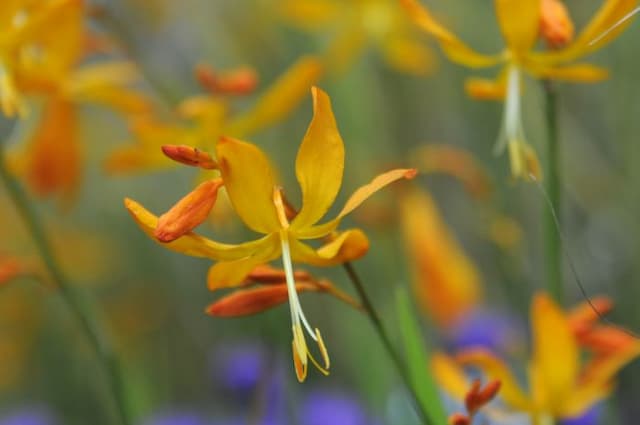
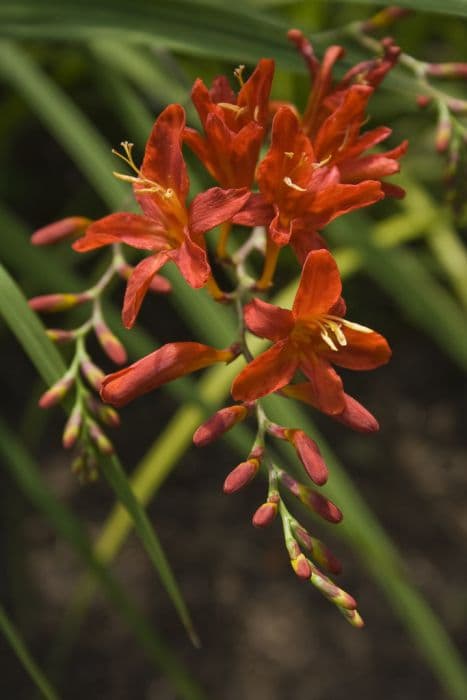
![Montbretia [Bright Eyes]](/_next/image?url=https%3A%2F%2Fplants-admin.emdemapps.com%2Fimages%2Fplants%2F%2Fimages%2F604b5f4a483b6.png&w=640&q=75)
